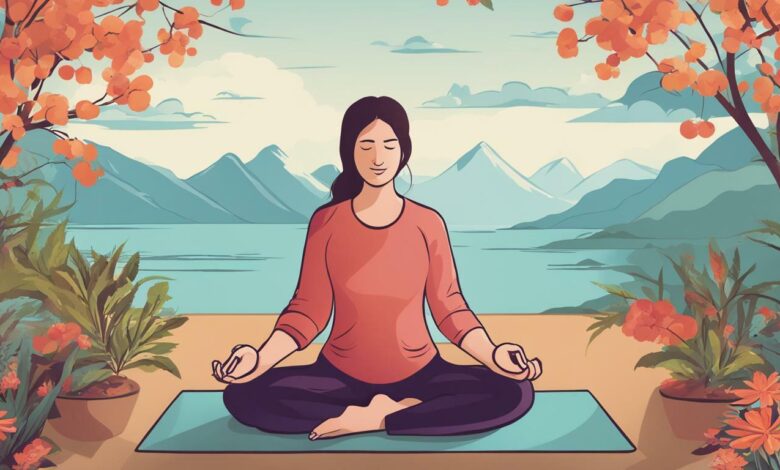Managing Migraine Headaches without Medication: Effective Approaches

Migraine headaches can be debilitating, with symptoms such as intense pain, nausea, and sensitivity to light and sound. While medication is often used to manage migraines, there are non-medication approaches that can be effective in preventing and reducing the frequency and severity of migraines.
In this section, we will explore several approaches to managing migraines without medication. We will discuss relaxation techniques, dietary adjustments, lifestyle changes, and tracking migraine triggers to help you find relief from your symptoms.
Key Takeaways:
- There are non-medication approaches to managing migraine headaches.
- Relaxation techniques such as deep breathing and meditation can help alleviate symptoms.
- Dietary adjustments such as keeping a food diary and avoiding trigger foods can prevent migraines.
- Lifestyle changes such as regular exercise and stress management can reduce the frequency and severity of migraines.
- Tracking migraine triggers and patterns can help identify common triggers and prevent future attacks.
Understanding Migraine Headaches and Their Symptoms
Migraine headaches are a neurological disorder that causes severe, recurring headaches. If you have migraines, you may experience intense, throbbing pain that can last for several hours or days. A migraine headache can be accompanied by symptoms such as sensitivity to light, sound, or smells, nausea, and vomiting.
It’s essential to understand the nature of migraines to manage them effectively without medication. Migraines are a complex condition that involves changes in the brain’s chemistry and function, as well as genetic and environmental factors. While there’s no cure for migraines, medication can help relieve symptoms and reduce the frequency of attacks.
The exact cause of migraines is unknown, but research suggests that they are linked to abnormal brain activity that affects the nerves and blood vessels in the head and neck. The changes in brain function can trigger a series of events that cause inflammation and pain in the blood vessels surrounding the brain.
People who experience migraines often have specific triggers that can bring on an attack. Common triggers include stress, lack of sleep, certain foods, hormonal changes, and environmental factors such as bright lights or strong smells.
Relaxation Techniques for Migraine Relief
When it comes to managing migraines without medication, relaxation techniques can be a highly effective approach. By calming the mind and body, these techniques can help reduce the severity and frequency of migraine symptoms. Here are some non-medication approaches for managing migraine headaches, specifically relaxation techniques:
Deep Breathing Exercises
Deep breathing exercises can help promote relaxation, reducing tension and stress in your body that may trigger migraines. To try this technique, find a quiet place where you won’t be disturbed. Sit or lie down, close your eyes, and breathe in slowly through your nose, filling your lungs with air. Hold your breath for a few seconds before exhaling slowly through your mouth. Repeat this process several times, feeling your body relax with each deep breath.
Meditation
Meditation can be an effective way to calm the mind and reduce stress, which can help alleviate migraine symptoms. To begin, find a quiet, comfortable place to sit or lie down. Close your eyes, focus on your breath, and try to clear your mind of all thoughts. If your mind wanders, gently redirect your focus back to your breath. Start with just a few minutes of meditation per day and gradually increase the duration as you become more comfortable with the practice.
Progressive Muscle Relaxation
Progressive muscle relaxation involves tensing and then releasing each muscle group in your body, promoting relaxation and reducing stress. To try this technique, find a quiet place where you won’t be disturbed. Sit or lie down and focus on each muscle group, starting with your feet and working your way up to your head. Tense each muscle group for a few seconds, then release the tension and let the muscle group relax completely. Repeat this process for each muscle group in your body.
By incorporating relaxation techniques into your daily routine, you can effectively manage migraine headaches without medication. However, it is important to consult with a healthcare professional if your migraines are severe or if you experience any new or concerning symptoms.
Dietary Adjustments for Migraine Prevention
If you suffer from migraines, adjusting your diet can make a significant difference in managing your symptoms. Certain foods have been known to trigger migraines, including alcohol, caffeine, chocolate, aged cheeses, and processed meats. Keeping track of what you eat in a food diary can help identify which foods may be causing your migraines.
While it is essential to avoid trigger foods, it is also important to ensure you are getting the necessary nutrients to support a healthy body. Eating a balanced diet with plenty of fruits, vegetables, whole grains, lean proteins, and healthy fats can help prevent migraines and promote overall health.
A few dietary changes you can make to help prevent migraines:
- Stay hydrated and drink plenty of water throughout the day.
- Limit your intake of trigger foods, including alcohol, caffeine, and processed foods.
- Try incorporating more magnesium-rich foods into your diet, such as spinach, avocado, almonds, and black beans.
- Eat regularly throughout the day to maintain consistent blood sugar levels.
- Avoid skipping meals or fasting for extended periods.
It’s important to note that dietary adjustments may take time to show effects, so be patient and consistent with your changes. Consulting with a dietitian can also be helpful in developing a personalized meal plan that addresses your specific needs and preferences.
By being mindful of what you eat and making dietary adjustments, you can significantly reduce the frequency and severity of migraines.
Lifestyle Changes to Reduce Migraine Frequency
Aside from relaxation techniques and dietary adjustments, making certain lifestyle changes can significantly reduce the frequency and severity of migraines. If you experience migraines, making the following lifestyle changes can help:
- Exercise regularly: Engaging in regular exercise can increase your body’s production of natural painkillers and promote stress relief, both of which can be beneficial for migraine management.
- Get sufficient sleep: Maintaining a consistent sleep schedule and ensuring you get enough sleep each night can help prevent migraines triggered by sleep disturbances.
- Avoid triggers: Certain stimuli like bright lights, loud noises, and strong smells can trigger migraines. Avoiding these triggers whenever possible can help reduce the frequency of migraines.
- Manage stress: Stress is a common trigger for migraines. Engage in activities that promote relaxation and stress relief, such as meditation, yoga, or deep breathing exercises.
By incorporating these lifestyle changes into your routine, you can improve your overall well-being and significantly reduce the frequency and severity of your migraine headaches without medication.
Tips for Tracking Migraine Triggers and Understanding Their Patterns
If you suffer from migraines, it is crucial to track the potential triggers that could be causing them. Keeping a migraine diary can help you identify patterns and take steps to avoid triggers, reducing the frequency and severity of your migraines. Here are some tips for tracking your migraine triggers:
- Identify potential triggers – Keep a record of when and where your migraines occur, and note any potential triggers such as stress, lack of sleep, changes in weather, or certain foods.
- Track your symptoms – Record the severity of your migraines and any accompanying symptoms, such as nausea, sensitivity to light or sound, or visual disturbances.
- Keep a food diary – Certain foods can trigger migraines in some individuals. Keeping a food diary can help you identify which foods to avoid. Be sure to record the ingredients of each meal and any snacks you consume throughout the day.
- Share your diary with your healthcare provider – Bring your migraine diary with you to your appointments with your healthcare provider. They can help you identify patterns and triggers, and develop a plan to manage your migraines effectively.
Remember, tracking your migraine triggers and understanding their patterns is an important step in managing migraines without medication. By keeping a record of when and where your migraines occur and identifying potential triggers, you can take steps to avoid them and reduce the frequency and severity of your migraines.
The Importance of Seeking Professional Medical Advice
While non-medication approaches can be effective in managing migraines, it’s crucial to emphasize the importance of seeking professional medical advice, particularly for severe migraines. A healthcare professional can help diagnose migraines accurately and develop an appropriate treatment plan.
If migraines are severely impacting your daily life and non-medication approaches aren’t providing adequate relief, a healthcare professional may recommend medication to manage your symptoms. There are several different types of medications available for migraines, including triptans, ergots, and beta-blockers.
It’s also essential to consult a healthcare professional if you experience any concerning symptoms alongside your migraines, such as neurological issues or vision changes. These could indicate other underlying health conditions that require medical attention.
Remember, managing migraines is a collaborative effort between you and your healthcare team. By working together, you can find the most effective approach to manage your migraines and improve your overall quality of life.
Conclusion
Managing migraine headaches without medication is possible through various non-medication approaches. By incorporating relaxation techniques, dietary adjustments, lifestyle changes, and tracking migraine triggers, you can find effective relief and improve your quality of life.
Remember to track your symptoms and triggers in a migraine diary, and seek professional medical advice if your migraines are severe or interfering with your daily life. A healthcare professional can help diagnose and manage your migraines and offer medication options if necessary.
Don’t let migraines take control of your life. With the right approach, you can manage your symptoms and find relief without relying on medication.
FAQ
Q: What are the symptoms of a migraine headache?
A: Common symptoms of a migraine headache include severe throbbing pain, usually on one side of the head, sensitivity to light and sound, nausea, and vomiting.
Q: What are some relaxation techniques that can help alleviate migraine symptoms?
A: Relaxation techniques such as deep breathing exercises, meditation, and progressive muscle relaxation can help reduce the severity and duration of migraine headaches.
Q: Are there any dietary adjustments that can prevent migraines?
A: Yes, certain foods can trigger migraines in some individuals. Keeping a food diary and avoiding common triggers such as caffeine, alcohol, and processed foods can help prevent migraines.
Q: How can lifestyle changes reduce the frequency of migraines?
A: Making lifestyle changes such as incorporating regular exercise, practicing stress management techniques, and maintaining a consistent sleep schedule can help reduce the frequency and severity of migraines.
Q: How can I track my migraine triggers and patterns?
A: Keeping a migraine diary and recording potential triggers such as stress, hormonal changes, and certain foods can help identify patterns and enable better management of migraines.
Q: Is it important to seek professional medical advice for migraines?
A: It is crucial to seek professional medical advice, especially for severe migraines. Healthcare professionals can provide an accurate diagnosis, offer appropriate treatment options, and ensure proper management of migraines.




